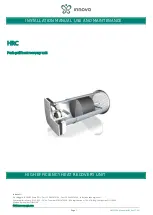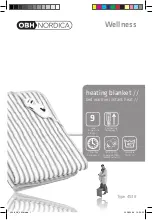
701
Thermo G
7 Servicing
7
Servicing
7.1
General
This section describes the work which is permitted to be
performed on the heater when it is installed.
Work on the heater must only be carried out by
trained and / or by Valeo-trained personnel.
Any work on the gas supply line, for example when
removing or installing the gas regulator, may only be
carried out by persons with the appropriate official
authorization.
The heater must be protected against being switched on
unintentionally.
NOTE:
When checking for leaks in the gas path it is recommen-
ded to use a suitable for gas leak detection spray or a gas
detector.
Often into the gas an odorant (fragrance) is mixed, by
which a leakage can also be perceived by a distinct odor.
7.2
Heater Servicing
Due to the risk of overheating, the battery main supply
may not be disconnected, as long as the heater is opera-
ting or in purge cycle.
Make sure that the circulating pump is running while the
heater is switched on for tests/inspections.
When comprehensive repair work is being carried out on
the heater, it is advisable to remove it from the vehicle.
After work has been carried out at the heat circuit, a coo-
lant mixture of water and antifreeze must be replenished
in accordance with the vehicle manufacturer’s instructions
and the heating circuit must be bleeded.
7.3
Vehicle Servicing
ATTENTION:
In the vicinity of the heater a temperature of 110 °C
must under no circumstances be exceeded (e.g.
during paint work on the vehicle).
7.4
Heater test run
The heater must not be operated, not even with the
timer, in enclosed areas like garages or workshops
not equipped with exhaust ventilation facilities.
7.5
Servicing
In order to ensure long-term functional reliability, the follo-
wing maintenance activities should be performed :
–
The openings of the combustion air intake grid and the
exhaust outlet must be checked for contamination and
cleaned as needed.
–
Outside the heating season the heater should be
operated with the vehicle engine cold approximately
every four weeks for 10 minutes setting the heating
system to "warm". In this way, starting problems at
the beginning of the heating season will be avoided.
–
Every three months accumulated oil and condensate
must be drained in accordance with 5.5.11.5 at the oil
drain plug of the gas pressure regulator.
ATTENTION:
If solid particulate matter is found in the oil/
condensate, the gas pressure regulator must be
replaced.
–
The gas presure regulator must be replaced every 4
years for safety reasons (ageing of the seals).
–
When renewing the coolant for the vehicle’s engine,
care must be taken to bleed the heater, after the ve-
hicle’s cooling system has been bled. Turn on the
circulating pump (if there is a separate switch) or turn
on the heater for approx. 5 seconds and operate the
circulating pump in the purge cycle. This procedure
may have to be repeated. Insufficient coolant must be
replenished in accordance with the manufacturer’s
instructions.
NOTE:
The Aquavent 6000C circulating pump has a dry
running protection which deactivates the motor in a
dry run after approx.10 seconds. The Aquavent
4800SC and 6000SC are shutting down in a dry run
only after 45 minutes.
The system is reactivated by disconnecting it from the
power supply for approx. 2 minutes.
–
At the latest at the beginning of the heating season,
the heater and the gas pressure regulator must be
tested by a professional.
Danger to life and health!
Warning!
Risk of Suffocation!
Warning!
















































